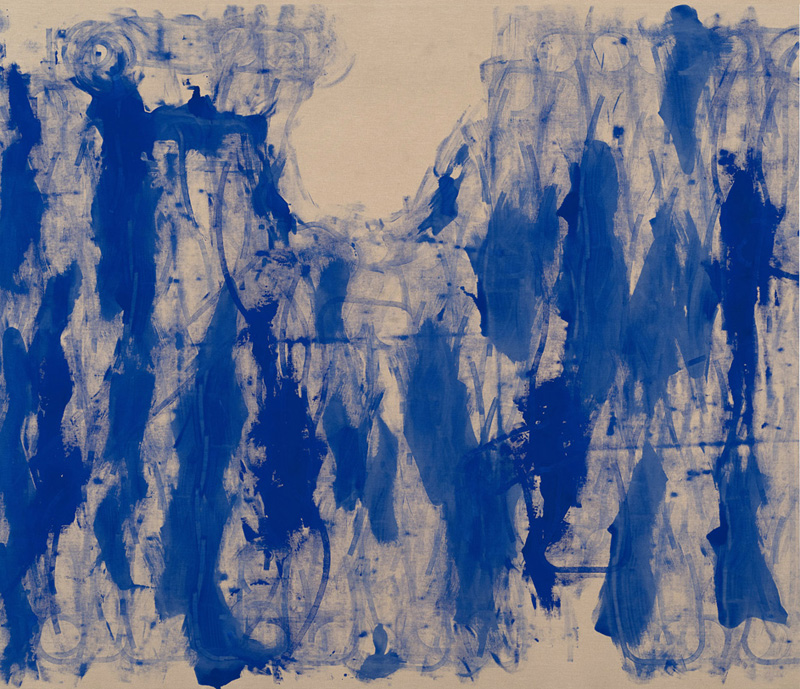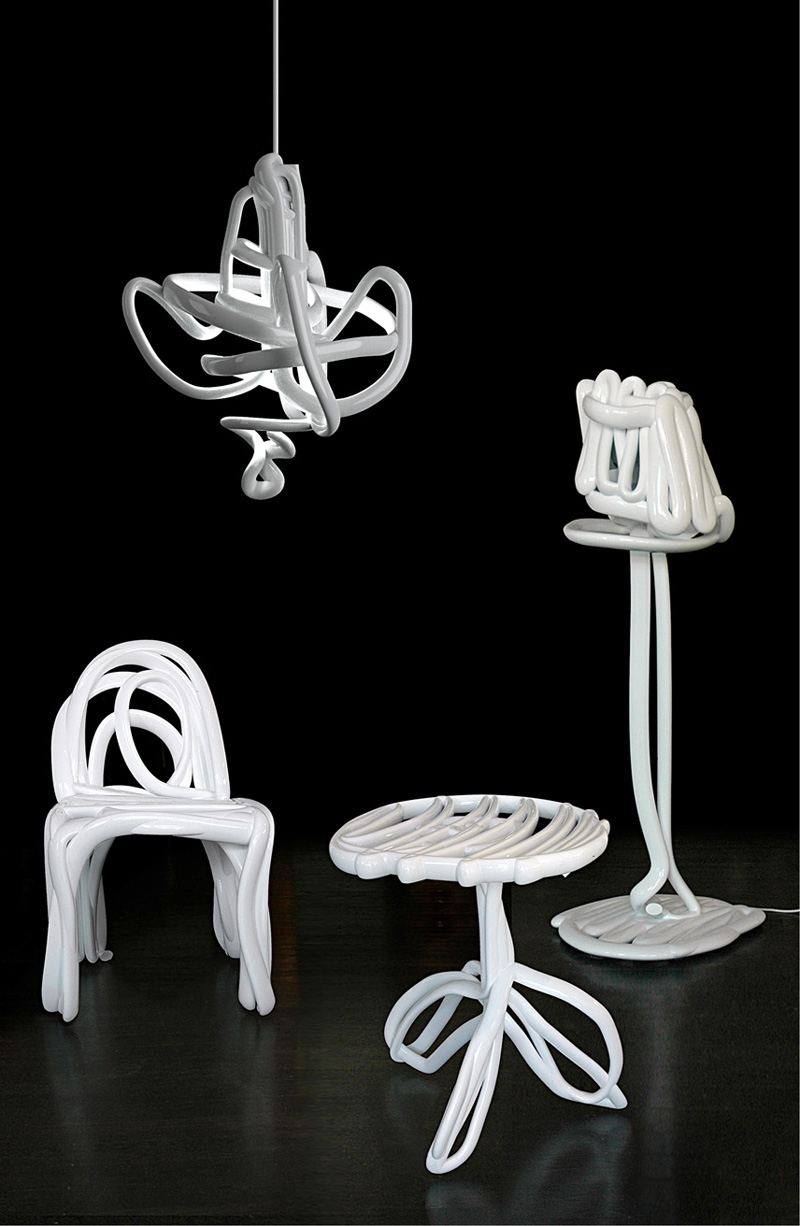Drawing Machine

38. The paintings in Addie Wagenknecht's Alone Together series (2017) are produced by a Roomba domestic robot as it traces around the artist's reclining body, smearing International Klein Blue paint as it goes. The work responds to both the technologized automation of labor and the history of action painting, where women's bodies were sometimes used as paint brushes.
Brief
Create a program that expands, augments, muddles, complicates, questions, analyzes, spoils, undermines, improves, accelerates, or otherwise alters the concept or act of drawing. Clarify the intent of your system, such as whether your project is a tool, toy, game, or performance instrument. Demonstrate its unique properties by using it to produce a series of at least three drawings.
Learning Objectives
- Deeply examine the process of drawing
- Evaluate the affordances and artifacts of creative tools
- Use appropriate data structures for recording, storing, and manipulating gesture data
Variations
- Create a system that brings drawings to life.
- Question intent. Derive marks from the actions of an entity that is (probably) unaware that it is drawing: a pedestrian, a turtle, a kite.
- Deprivilege the dominant hand. Make a drawing tool that is operated by the user's face, voice, or some other part of their body.
- Drawing is usually conceived as a solo activity. Create a drawing machine that requires two people to operate it.
- Make a “single purpose” drawing machine, such as a tool that can only draw ducks.
- Identify and challenge some other basic assumption about drawing, such as the notion that drawings are made on a flat surface; that drawings are recordings that are meant to endure; that drawings can be “finished”; or that drawings are distinct from text.
- Make a tool that functions critically—for instance, that rejects the technological imperatives of accuracy, realism, and utility and instead prioritizes expressivity, irreproducibility, and whimsy.
- Develop a system that analyzes and derives insights from a database of drawings.
Making It Meaningful
“Make your own paintbrush” is a classic art school prompt, encouraging students to create tools from parts of the body or found materials. The exercise personalizes and defamiliarizes the act of mark-making, and invites a deeper consideration of how tools and technologies shape artistic expression. The Drawing Machine assignment captures this spirit in the domain of software, opening up questions of constraints, autonomy, and augmentation in human-machine collaboration.
The act of drawing translates gesture from the body to the page through an apparatus. The primogenitor of today's computational drawing tools was Sketchpad, developed by Ivan Sutherland as part of his MIT PhD thesis in 1963, which made it possible for a person and a computer “to converse rapidly through the medium of line drawings.” i Widely credited as the first graphical user interface, Sketchpad substituted page for screen and leveraged the infinite malleability of virtual form for the first time. Its descendants, like AutoCAD, Photoshop, and Illustrator, are now mature products, and their interaction vocabularies have become standardized and ubiquitous and thus taken for granted. Innovating in this space now requires either breaking a core assumption about drawing, or experimenting with mark-making in unfamiliar contexts.

39. Sougwen Chung collaborates with semi-autonomous robot arms to produce drawings like those in her Drawing Operations series (2015–2018).

40. To create Tree Drawings (2007), Tim Knowles attaches pencils to the limbs of trees and captures the resulting marks on paper.

41. The Sketch Furniture (2007) system by Swedish agency Front Design combines motion capture and digital fabrication. Using this system, a designer can record three-dimensional, freehand drawings of virtual furniture at a 1:1 scale, and then fabricate these forms using a large-scale 3D printer.

42. Graffiti Research Lab was a collective dedicated to outfitting artists and protesters with open-source technologies for urban communication. In L.A.S.E.R. Tag (2007), a computer vision system tracks the spot of a user's handheld laser pointer. A high-power video projection, calibrated to the camera system, enables the user to display their tags at an architectural scale.

43. Sloppy Forgeries (2018) by Jonah Warren is a game in which players, using computer mice and simplified color palettes, race to draw the most accurate replicas of famous paintings.

44. In Julien Maire's Digit performance (2006), poetic texts magically appear beneath the artist's fingertip as he runs it across a sheet of white paper. Mechanisms from a thermal printer have been discreetly concealed under his hand.

45. Paul Haeberli's DynaDraw (1989) is an early computational drawing environment in which the brush is modeled as a springy physical object with simulated mass, velocity, and friction. The augmentation of the drawing process with exaggerated virtual physics, and a range of adjustable parameters, leads to new forms of gestural and calligraphic play.
Additional Projects
- Akay, Tool No. 10: Robo-Rainbow, 2010, device for spray-painting rainbows.
- Peter Edmunds, SwarmSketch, 2005, collaborative digital canvas.
- Free Art and Technology (F.A.T.) Lab, Eyewriter, 2009, eye-tracking drawing tool.
- William Forsythe, Lectures from Improvisation Technologies, 1994, video series.
- Ben Fry, FugPaint, 1998, antagonistic paint program.
- Johannes Gees, Communimage, 1999, digital collaborative collage.
- David Ha, Jonas Jongejan, and Ian Johnson, Sketch-RNN Demos, 2017, neural network drawing experiment.
- Desmond Paul Henry, Serpent, 1962, pen and ink mechanical drawing, Victoria and Albert Museum, London.
- Jarryd Huntley, Art Club Challenge, 2018, drawing game iOS app.
- Jonas Jongejan et al., Quick, Draw!, 2017, drawing game with neural net.
- So Kanno and Takahiro Yamaguchi, Senseless Drawing Bot, 2011, chaotic drawing robot.
- Soonho Kwon, Harsh Kedia, and Akshat Prakash, Anti-Drawing Machine, 2019, antagonistic drawing machine.
- Louise Latter and Holly Gramazio, Doodle, 2020, exhibition of software art at Birmingham Open Media (BOM).
- Jürg Lehni, Viktor, 2011, scalable robotic drawing machine.
- Golan Levin, Yellowtail, 1998, audiovisual animation software.
- Zachary Lieberman, Drawn, 2005, interactive installation.
- Zachary Lieberman, Inkspace, 2015, accelerometer-dependent drawing app.
- John Maeda, Timepaint, 1993, drawing software demonstration.
- Kyle McDonald and Matt Mets, Blind Self-Portrait, 2011, machine-aided drawing system.
- JT Nimoy, Scribble Variations, 2001, drawing software.
- Daphne Oram, Oramics Machine, 1962, photo-input synthesizer for “drawing sound.”
- James Paterson and Amit Pitaru, Rhonda Forever, 2003–2010, 3D drawing tool.
- Pablo Picasso, Light Paintings, 1950, long-exposure photographs by Gjon Mili, Museum of Modern Art, New York.
- Amit Pitaru, Sonic Wire Sculptor, 2003, app for 3D drawing and composition.
- Eric Rosenbaum and Jay Silver, SingingFingers (Finger Paint with Your Voice), 2010, software for fingerpainting with sound.
- Toby Schachman, Recursive Drawing, 2012, drawing software.
- Karina Smigla-Bobinski, ADA, 2011, analog interactive installation.
- Alvy Ray Smith and Dick Shoup, SuperPaint, 1973–75, 8-bit paint system.
- Scott Snibbe, Bubble Harp, 1997, drawing software implementing Voronoi diagrams.
- Scott Snibbe, Motion Phone, 1995–2012, networked animation system.
- Scott Snibbe et al., Haptic Sculpting, 1998, prototype software for physically mediated haptic sculpting.
- Laurie Spiegel, VAMPIRE, 1974–1979, color-music mixing software.
- Christine Sugrue and Damian Stewart, A Cable Plays, 2008, audiovisual performance.
- Ivan E. Sutherland, Sketchpad: A Man-Machine Graphical Communication System, 1964, drawing program.
- Clement Valla, A Sequence of Lines Consecutively Traced by Five Hundred Individuals, 2011, video.
- Jeremy Wood, GPS Drawings, 2014, drawings from GPS data.
- Iannis Xenakis, UPIC, 1977, graphical music scoring system.
Readings
- Pablo Garcia, “Drawing Machines,” DrawingMachines.org, accessed April 14, 2020.
- Jennifer Jacobs, Joel Brandt, Radomír Mech, and Mitchel Resnick, “Extending Manual Drawing Practices with Artist-Centric Programming Tools,” in Proceedings of the 2018 CHI Conference on Human Factors in Computing Systems (New York: Association for Computing Machinery, 2018), 1–13.
- Golan Levin, “2-02 (Drawing),” Interactive Art and Computational Design, Carnegie Mellon University, Spring 2016, accessed April 14, 2020.
- Zach Lieberman, “From Point A to Point B” (lecture, Eyeo Festival, Minneapolis, MN, June 2015), video, 7:20–19:00.
- Scott Snibbe and Golan Levin, “Instruments for Dynamic Abstraction,” in Proceedings of the Symposium on Nonphotorealistic Animation and Rendering (New York: Association for Computing Machinery, 2000).